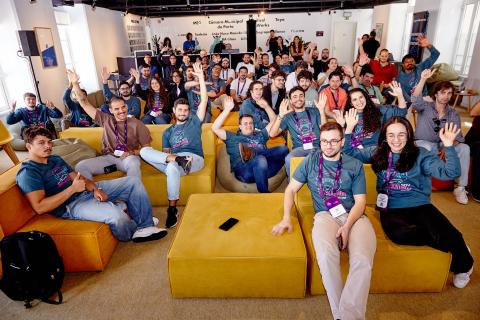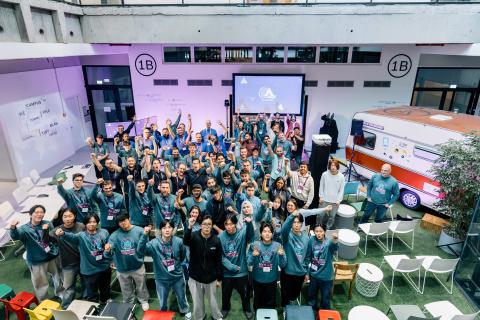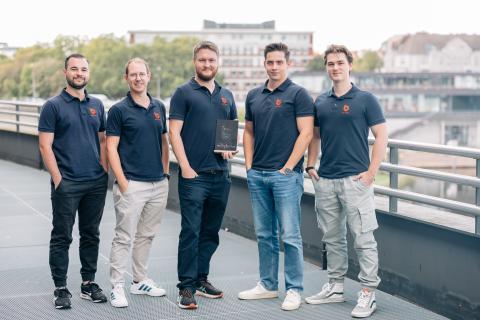Last week at the SDV Hackathon Chapter Three, a total of 102 participants gathered at Bosch Innovation Campus, Berlin, and at 42 Porto to build innovative features powered by software-defined vehicle (SDV) technologies. For the first time, the hackathon was held in two cities simultaneously – and it was a blast.


Over the course of two and a half days, 22 teams collaborated to brainstorm, code, and prototype innovative solutions, guided by hack coaches from leading organisations such as ETAS, Red Hat, Elektrobit, T-Systems, and Bosch. Participants tackled two distinct challenges, using Eclipse technologies such as Eclipse Ankaios, Eclipse Kuksa, Eclipse Symphony, Eclipse Velocitas, Eclipse Mosquitto, Eclipse ThreadX, Eclipse uProtocol, Eclipse Muto, Eclipse Zenoh, Eclipse OpenBSW and more.
Following 30 hours of intensive coding, interspersed with occasional fun and recreational activities, seven finalist teams were selected. Their projects stood out for their innovation and practical applicability, leaving a lasting impression on the judges. While each of the solutions is quite unique and would deserve an article of its own, we briefly summarised the "glorious seven" for you in the following section.
The nominees are …
SDVenturers
The team SDVenturers (Berlin) tackled the Virtual SDV Lab challenge. Their focus was on mood detection and adaptive car behaviour – that is, using sensors and AI to infer the driver’s emotional or physiological state through bio signals such as heart rate, eye behavior – and then adjusting the car’s control systems (often the ECU) accordingly. Their goal was, obviously, to ensure safety on the road. Python, Rust and Eclipse ThreadX were part of their technology mix, see their GitHub Repository.
TheBigRanch
TheBigRanch (Porto) also selected the SDV Lab challenge. Their core idea was to build a pothole detection and mapping system, i.e. detecting bumps or vertical irregularities in the road surface, and aggregating them into a map to notify future travellers for safer driving. Among other technologies, they used the CARLA simulator, Eclipse Ankaios as orchestrator, and Eclipse Zenoh as protocol. See their GitHub repository for more information.
A-kiki
A-kiki’s version of the SDV Lab challenge was an autonomous lock-on and coordinated pursuit system. The Berlin team proposed a solution that enables police vehicles to lock on to a suspect vehicle, pursue it autonomously, and coordinate with other units – all with minimal manual intervention. The goal is to address the extremely high driver/officer workload and poor coordination. Apart from Eclipse Zenoh and CARLA, the team used ROS 2 Humble, VSS, and WebSocket. See their repo for more details.
ArbytesMoral
Another variation of the SDV Lab challenge was offered by the team ArbytesMoral (Berlin): CarMate, an AI-powered, voice-driven, and context-aware companion for vehicles designed to improve driver well-being. This solution, built with Eclipse uProtocol, Eclipse Zenoh, Eclipse Kuksa, Eclipse Ankaios, MQTT, and CARLA, among other tech ingredients, tackles the issue of long and solitary journeys, during which drivers – such as long-haul truckers – may be tempted to engage with on-board infotainment systems, thereby compromising their safety. If you’d like to know more about CarMate, check out their GitHub repo and one team member’s LinkedIn post.
Although more finalist teams tackled the SDV Lab challenge, three also opted for the Update Possible challenge:
MegaBosses
Over the air (OTA) updates are a tough nut to crack in today’s smartphone-inspired consumer tech world, especially in the automotive industry, where, as some say, we are dealing with “smartphones on wheels.” This is why MegaBosses (Porto) came up with a practical, end-to-end solution built with Eclipse Symphony, Eclipse uProtocol, Eclipse Ankaios, and Eclipse Muto, demonstrating how effectively Eclipse SDV technologies can be combined to address modern challenges for SDVs. Check out their GitHub repo.
LastOneStanding
As the name suggests, LastOneStanding (Berlin) was a one-man team proposing to enable OTA updates for the Electronic Control Units (ECUs) by utilising a self-hosted cloud data broker that operates on Kubernetes. This broker serves as the communication channel between Original Equipment Manufacturers (OEMs) and their fleet of vehicles. For this, the participant proposed to leverage the Eclipse SDV technologies Eclipse Ankaios, Eclipse Symphony, and Eclipse uProtocol. The overarching goal of this approach is to allow OEMs to gain full control and transparency over their OTA update process without relying on proprietary or vendor-locked systems. The pitching slide deck for this project can be found on GitHub.
COOTA
The team name COOTA stands for “Canary Orchestrator for Over The Air”, and this was exactly what this Porto team was building at the hackathon. As the word “Canary” in their name suggests, their solution aimed to support progressive rollouts as well as realtime error monitoring and telemetry, thus ensuring safe, scalable, and adaptive OTA deployments. Their GitHub repo boasts an elaborate logo (featuring – of course – a yellow bird) and tagline: “Updating mobility, orchestrating trust.”
And the winners are …
We’d like to say “everyone”, but since a hackathon is all about competing, our amazing jury members had to appoint three winners based on judging criteria (all of which are made transparent here) such as usability, creativity, and coding aspects.
Congratulations to ArbytesMoral from CarByte Engineering, who won the first prize (see their LinkedIn post and team picture below), and to SDVenturers, and MegaBosses, for winning the second and third place!

Ultimately, the greatest success was the remarkable creativity and teamwork demonstrated by all participants and the tireless support of our hack coaches. Sincere thanks to Bosch in Berlin and 42 in Porto for their generous hosting and for making this event possible!
More impressions from the hackathon
For more voices and comments on the Eclipse SDV Hackathon 2025, check out the hashtag #SDVHackathon25 on social media and our Flickr albums for Porto and Berlin. Also, stay tuned for our recap video – to be published shortly on our YouTube channel – for more visual impressions.
